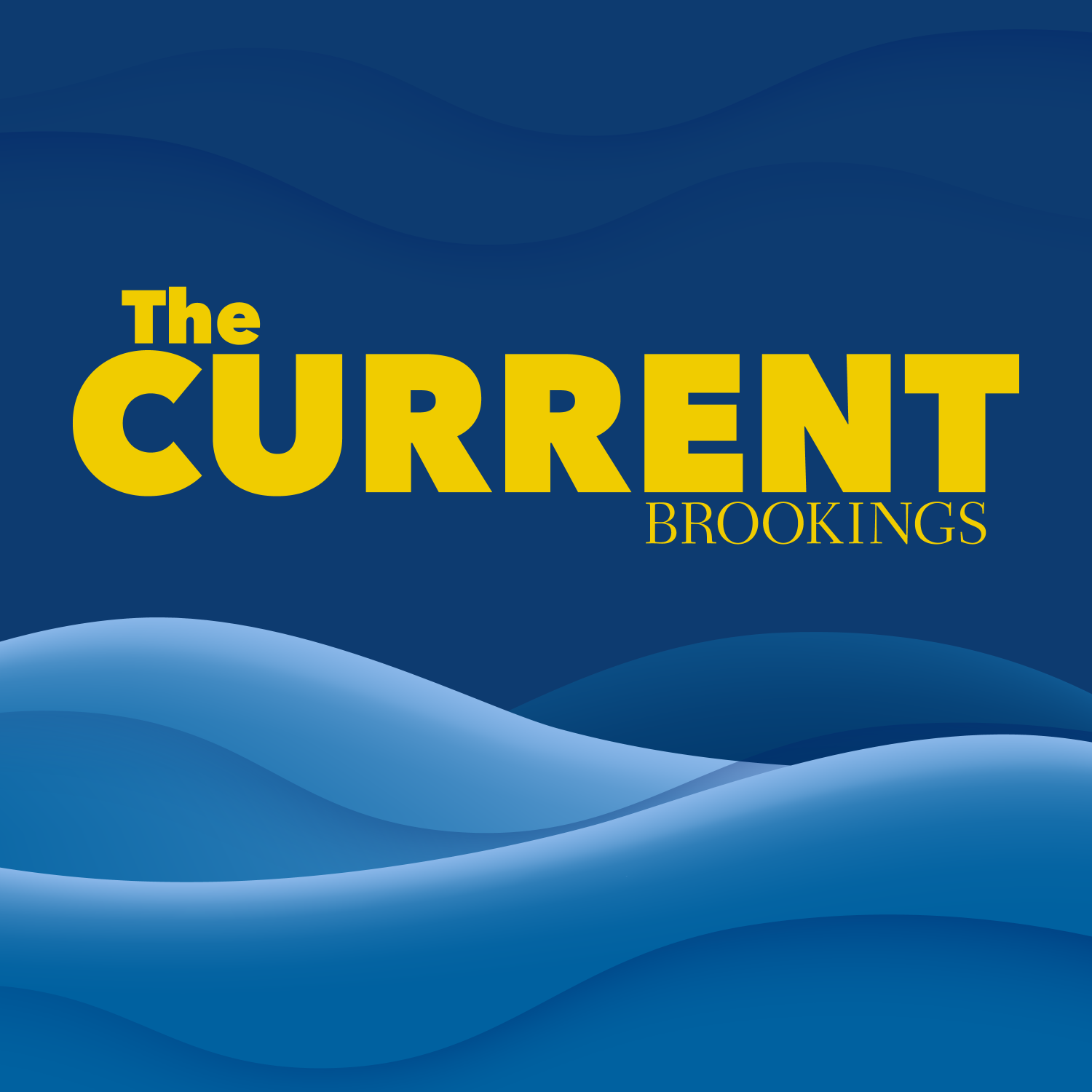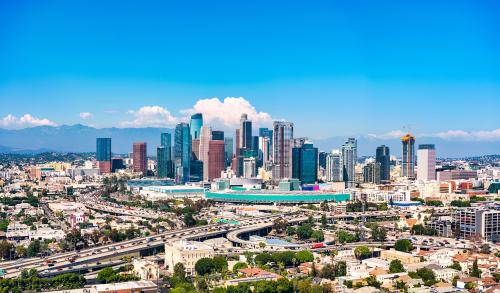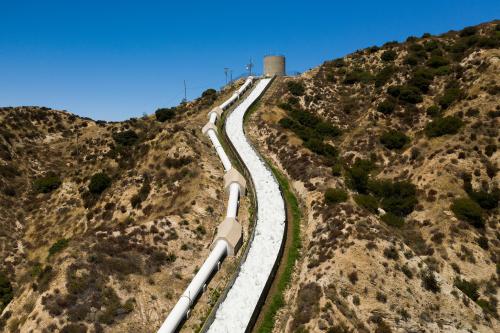20 years after Hurricane Katrina made landfall along the Gulf Coast, researchers from New Orleans, Brookings, and The Data Center are examining how the city has recovered and the challenges it still faces. Manann Donoghoe joins The Current to talk about the extensive new analysis, the many factors that make a city resilient, and the areas policymakers should be investing in to ensure communities can adapt to extreme weather events and other shocks.
Transcript
PITA: You are listening to The Current, part of the Brookings Podcast Network. I’m your host, Adrianna Pita. When Hurricane Katrina made landfall 20 years ago on August 29th, 2005, and the levies protecting the city of New Orleans failed, more than 1 million homes were destroyed, more than 1 million people displaced, and resulting devastation exposed long-running economic and racial inequalities and institutional weaknesses.
Over the years, Brookings and the Data Center, a Louisiana-based nonprofit research institution, have collaborated on tracking the New Orleans region’s recovery. What was first the Katrina Index, then the New Orleans Index, and now in a new series, New Orleans 20 years after Hurricane Katrina, researchers are exploring the city’s remarkable progress and the persistent challenges that still remain.
With us today is Manann Donoghoe, a fellow with Brookings Metro and part of the team of researchers working on the series. Manann, thanks for talking to us today.
DONOGHOE: Thanks for having me.
PITA: So in those first couple years after the storm, recovery tracking consisted of a lot of, of hard numbers, right? How many homes were destroyed, how many rebuilt, how much money was spent, how many people have come back. At the 20-year mark, this series has a broader scope. A lot of it is very forward looking, what’s been achieved, but also what comes next. Maybe you could start us off by framing the project: what are some of the range of issues that everyone was looking at, and what’s the overall story that you all found there?
DONOGHOE: Right. You know, I want to start by saying we didn’t want to just do a before and after comparison of New Orleans. We didn’t want to just look at, at disaster recovery and, and then where we are today. Instead, we wanted to take, like you said, a broader frame on resilience. Really trying to understand how resilient the metro area is today, how resilient communities are within the metro area today. And to answer that bigger question, we had to have a bigger scope.
So we look at a range of different data points, different kinds of policy issues for a range of different kinds of what you could call systems. Things like job markets, local job markets, things like wealth and inequality, things like civic engagements, even things like the health of ecosystems and how they help us adapt to the impacts of floods and other extreme weather events.
So, you know, to step back for this series, we have two main kind of products, for lack of a better word. We, we have an index, which is 20 different variables, data points, looking at progress in all those different factors that I mentioned across 20 years going back to pre-Hurricane Katrina.
And then we also have a deeper dive and in-depth report series where we have a series of authors, some from the Brookings Institution and others, local academics and practitioners from New Orleans, local residents who are looking at specific issue areas, things like environmental justice and pollution, community safety and criminal justice, flood adaptation, water planning, transportation infrastructure, all these various kinds of issues.
We’ve got five of those deeper dives on the website at the moment, and we’re going to be adding to them over the month of, of August.
Now you also mentioned the bigger picture. So, you know, I’d start by saying that New Orleans has seen tremendous recovery in many different ways. You know, looking at the 20 years of progress, there are some real bright spots. We’ve seen economic diversification, lots of new startups in the city as well. Strong entrepreneurialism. We’ve seen increases in rates of education, higher education, increases in internet access and strong social cohesion.
But there’s also some challenges, and particularly on the economic side. The local economy is still struggling. The job market is not what it could be. And poverty, while it’s decreased in New Orleans City, actually the surrounding area, the broader metro area, you’ve seen rates of poverty increase.
And then also particularly to address climate and disaster impacts, the rates of flood insurance and home fortification is also lower than what we would like them to be.
PITA: Can I ask you to dig a little bit more into this idea about resilience? We talk about that a lot strictly in the climate sense, but it sounds like the series has a, a bigger picture view on resilience as well. Can you tell us a little bit more about that and what that means for cities?
DONOGHOE: Right, absolutely. So I think resilience is a particularly good lens to think about problems today. We’re in a world where the climate is literally different to what it was even 20 years ago. It’s an increasingly unstable climate, more extreme events. And also more different kinds of shocks as well. You know, we just came out of a global pandemic. Cities are also facing these unique and different kinds of threats, and resilience can also help us to understand those.
So, you know, the core of resilience is what you might imagine. It’s the ability of a place or a region to bounce back from an extreme event. Again, from a hurricane, from a pandemic, any kind of shock.
But there’s a little bit more to it. The first is that instead of just thinking about places and people, we are also thinking about systems. The economy is a system. How strong is the economy? Ecosystems like wetlands, floodplains, these are systems as well.
Civic infrastructures like community groups, governance structures. These are systems. And resilience is about understanding how these systems fit together, how strong they are together, and how they work collectively.
And then the final thing I’ll say as well about resilience, and this one is particularly important, it’s not just about recovery because we don’t want cities, regions to recover just back to where they were before. We want them to recover to a better place, to a place where there’s the capacity for learning and transformation, where they’re in a more adaptive place. And that, that really is, especially today, is incredibly important aspect of resilience.
PITA: In that sort of general picture of. New Orleans has largely recovered, but there’s a lot of these caveats, sort of asterisks on a lot of that data, were there any findings or any of this analysis that was done that surprised you or that really stood out as an outlier?
DONOGHOE: Yeah, there were a couple. You know, I’ll start by saying I’m not a New Orleans local. We have people on this project who are—Andre Perry, who’s also engaged on the series, spent 10 years of his career in New Orleans. And our partners at the Data Center as well. But I’m not, so I kind of bring an outsider perspective to this.
And in fact, in a way I’m a double outsider because I’m coming from Australia as well—disaster-prone place, but very different context.
So something that particularly surprised me was just the, the way that the data shows how much New Orleanians want to stay in New Orleans and how much they care about New Orleans. The nativity rate, so this is the rate of people who grew up in New Orleans and remain there, is about 71%, which is much higher than other metro areas across the U.S.
Also there’s strong, rich, civic organizations. People are members of social clubs. That’s a, that’s a way of life in, in New Orleans. Clearly this is a place that people are invested in and that people want to stay. People want to build their communities. I was doing a interview with a journalist the other day and this question came up of, well, why are people still in New Orleans? You know, it’s a, a disaster-prone area. It’s a coastal city. It’s facing rising sea levels, facing increasing threats from disasters. Well, people want to stay there because the city’s got something to offer. They’re invested in that place. And that, that was a, a kind of unexpected finding and something that I, I thought was worth exploring deeper and worth building upon.
PITA: And actually, I didn’t think to ask what was the area that you particularly were focusing on in this series?
DONOGHOE: Yeah. So my particular focus area, I mean, you know, I bring to this research, a kind of perspective on climate disasters and extreme weather. That’s my, my kind of main issue area. But for this report series, I particularly focused on environmental justice and pollutants. So, how is pollution in the cities of, of New Orleans today, how has it changed over the last 20 years, and how could that intersect with disasters to create risks for communities?
PITA: I want to pick up on the point you were just raising about the social engagement and civic engagement that New Orleans is so strong with. And one of the really tragic aspects of Katrina and, and why the effects of the storm were so bad was just the complete breakdown in civic engagement and of governance and all these aspects.
And there was a quote, Mark Davis, who’s a professor at Tulane and director of Tulane Center for Environmental Law, in his paper he says, “as immense and powerful as the hurricane was, it was not the deliverer of most of the death, destruction, and displacement that followed in its wake. No, it was the failures of governance, engineering, law, science, and civics that we have to look to for those devastating results.”
Does this series go into those questions of civic engagement and social engagement and why that’s important for cities?
DONOGHOE: Yeah, absolutely it does. So, we have some kind of general data on civic engagement that I already mentioned in the, the New Orleans Index at 20, which is this, this kind of data product. But we also have a deeper dive into that as a policy issue as well, written by Professor Robert Collins. That’s actually on the website now, and he goes into detail in these questions of civic infrastructures.
I will say that in the history of disaster policymaking, Hurricane Katrina was somewhat of a turning point in one really specific way, which is what Mark Davis was getting at. And that’s the, the impact of disasters and the severity, it’s not just a product of the physical disaster itself. It’s not just about the hazard. It’s about all these other social and economic vulnerabilities that amplify the impacts of the disaster.
And that’s something that became horribly apparent during the immediate aftermath of Hurricane Katrina and has continued to guide changes to disaster policy since.
PITA: We’ve talked about how New Orleans is different than a lot of other cities. Strong sense of place, such a big native population. Also just its physical, geographical layout. What are some of the lessons that were learned from New Orleans that can be applied? As you mentioned, everywhere across the country and across the world are seeing increases in extreme weather events. What are the lessons here that other people can learn from?
DONOGHOE: Right. Yeah, exactly. So, New Orleans is not, it’s not isolated. It’s not in a unique position. It’s not, it’s not out there on its own as the only city in the U.S. facing extreme weather. There’s many cities across the U.S., coastal cities that are in a similar position, but also cities that are facing other kind of risks like wildfires, for example. Extreme heat.
I like to say that no city in the U.S., no place is truly immune to climate impacts or disaster impacts. And in that sense, the work that we’re doing on New Orleans to understand how resilient it is today is somewhat of a case study for these other cities.
And I think there is a clear message and that’s, that’s these kinds of extreme events we can’t predict when they’re going to occur. We can’t predict how bad they’re gonna be, but we do know that they are going to continue to occur with regularity. Okay? And that’s something that we should be planning for. And what we’re laying out here is the kinds of areas that cities, regions, states can be looking to invest in and, and to, to bolster to make sure that their citizens, their residents, the communities in those places are able to recover and adapt to that changing environment.
PITA: Well, the series really is remarkable. There are several papers, as you mentioned, that are already available on the Brookings website. Folks can go to Brookings dot edu. They can find the series right on the homepage. And as you mentioned, others are going to continue to be released throughout the month of August.
I think you all are wrapping up with an event in New Orleans on August 25th, and that is gonna be live streamed on the Brookings website as well. The listing’s not up yet. But if folks will come back to Brookings dot edu slash events in a week or two, they should see that and be able to watch some of the discussion.
Is this gonna be a lot of the researchers, the local researchers that you mentioned coming together to, to talk about their findings?
DONOGHOE: Absolutely. Yeah. At that event, we’ll have researchers on stage talking about their findings, their in-depth policy papers, as well as a host of other people.
PITA: Wonderful. Well, we’ll look forward to that, and thank you very much for talking to us today.
DONOGHOE: Thank you.
The Brookings Institution is committed to quality, independence, and impact.
We are supported by a diverse array of funders. In line with our values and policies, each Brookings publication represents the sole views of its author(s).







Commentary
PodcastHow resilient is New Orleans today?
Listen on
The Current Podcast
August 6, 2025